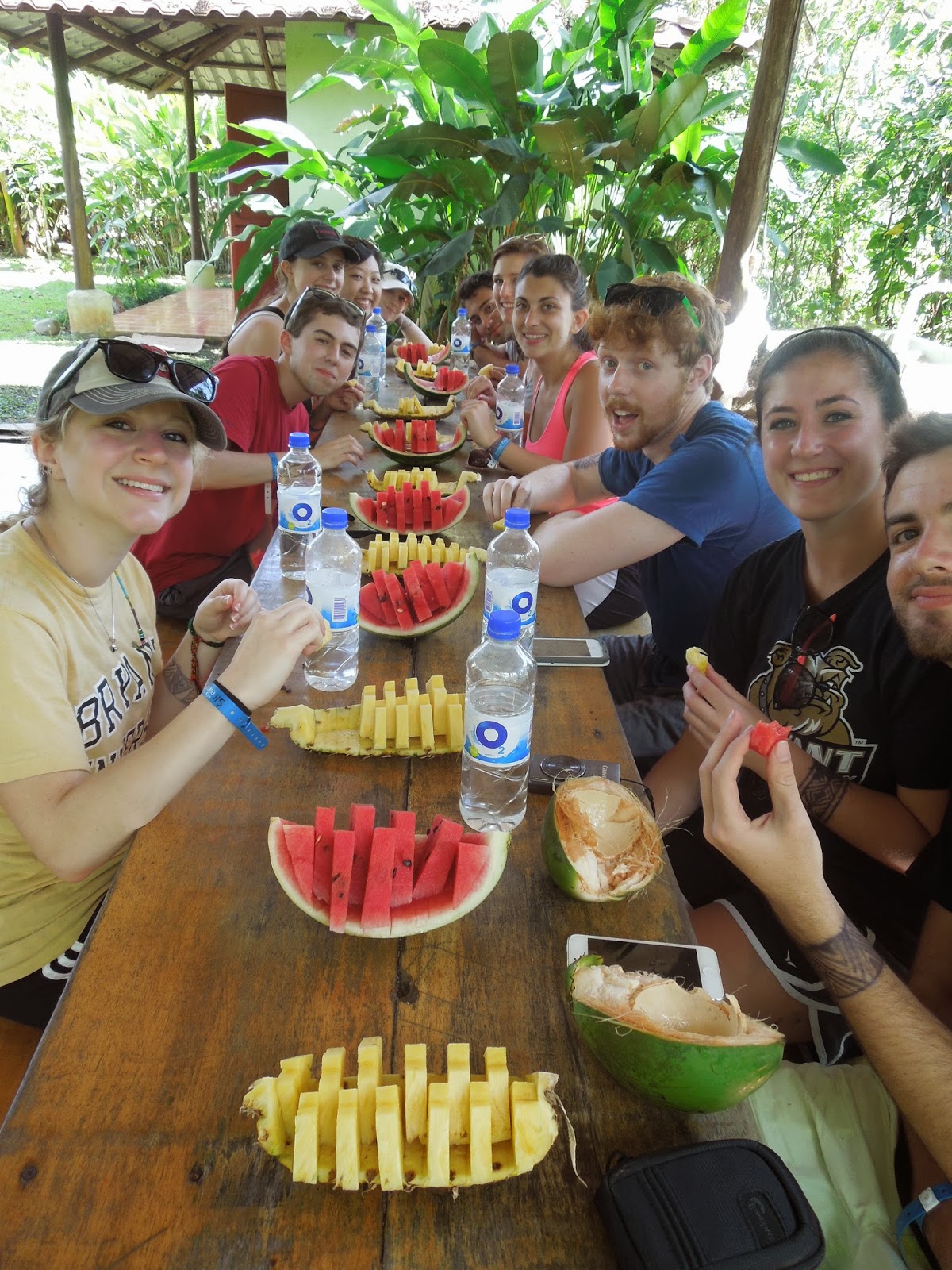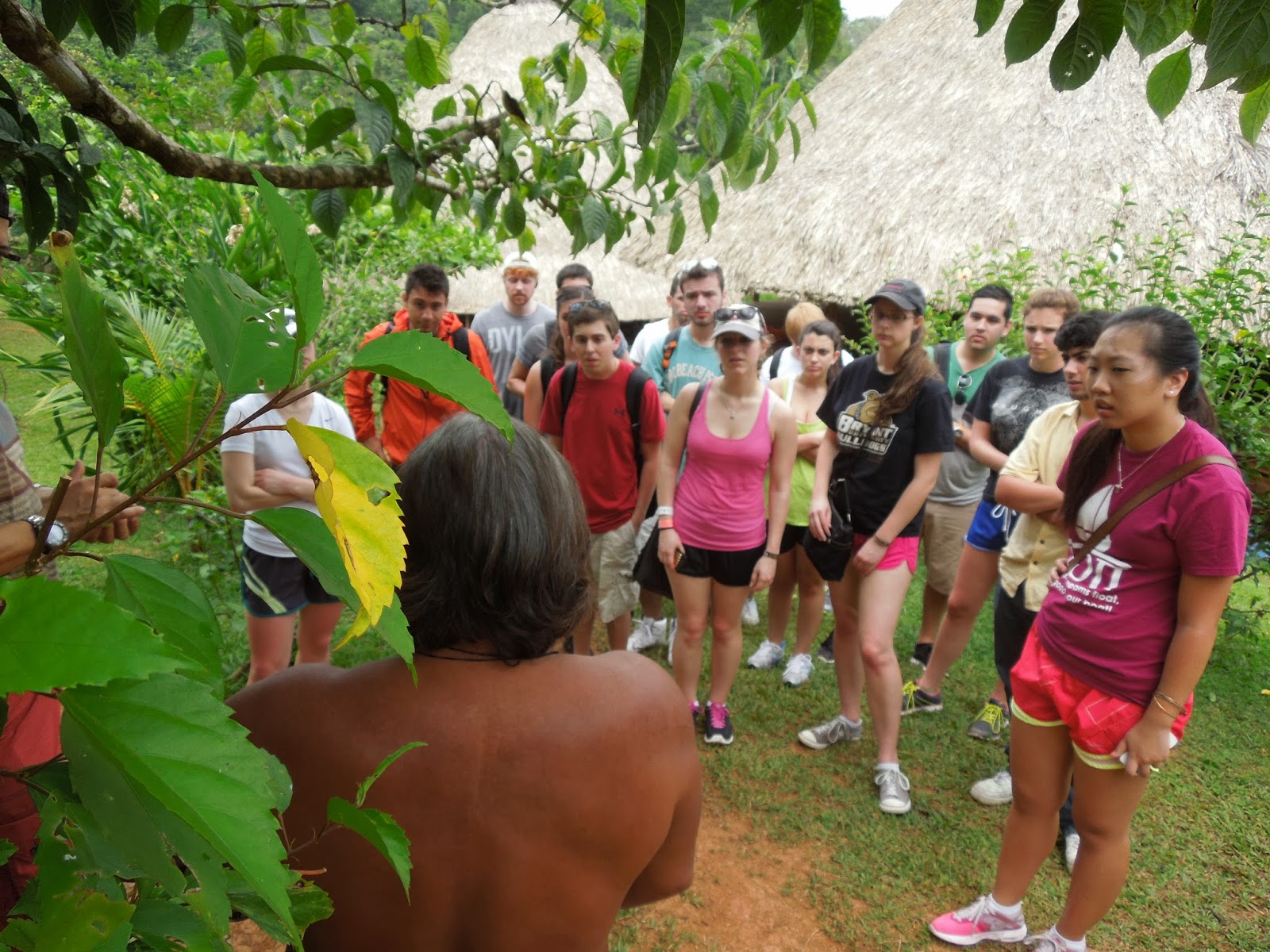When we arrived to the estate, we were served a delicious lunch, and also got a chance to sample some of Doka´s different roasts in sampling cups!
After lunch, our tour guide, Daniel, began to show us around the plantation. To start off, he explained why the area where Doka is located in Costa Rica is the best environment for coffee. The three main reasons are the higher elevation than other areas (about 4,500 ft above sea level), the volcanic soil, and the climate, which provides 6 months of rain and 6 months of sunlight. These conditions allow café arabica, or Arabica bean coffee, to thrive. Our tour guide informed us that in 1986, Costa Rica passed a law that stated that only Arabica coffee could be grown in the country, because of its high-quality characteristics. Because Costa Rica does not have the ability to compete with countries like Colombia in the quantity of coffee produced, the country focuses on producing quality coffee.
After this background, Daniel showed us the full process of how the coffee beans are grown and processed.
First, experts come to the plantation to choose the best coffee seeds, which are then planted in tiny containers, like in the ones below.
After 10-12 weeks, they are put into larger plastic bags, and kept their until they are about 1 year old. Finally, they are put into soil, and kept there for three years before they can fully produce the beans. We were all amazed that these plants take 4 years before they fully mature and produce beans! The coffee plants can live up to 50 years, but Doka only keeps each tree for about 25.
When it came to picking the beans off of the trees, Olivia and Matt got to experience the life of a coffee bean picker for a few moments. Daniel gave these two the challenge to figure out how they think pickers carry the baskets. They tried a couple odd ways...
But eventually they got the hang of it!
The workers are paid about $2 for every basket that they fill with ripe, red beans. Daniel estimated that an extremely good picker could fill about 25 baskets in a day, but that the average is abouit 8-10 a day. However, if the worker picks too many green coffee beans, when they bring the beans to the trucks to sell them at the end of the day, they may receive less than $2 for the basket. We got the chance to pop open up the red beans, to see the actual coffee beans inside! In this photo, Jordan decided to make an appearance in the picture and make a funny face.
When Katie opened hers, she found a surprise: she only had one bean! Daniel informed us that while most beans that are picked have two in them, rare ones only have one, and these ones make premium quality coffee, called peaberry coffee. These are of a higher quality than others because 100% of the nutrients of the bean gets transferred to one bean.
After the beans are put into trucks, the trucks bring them to a wet mill. The wet mill is where the beans are sorted, stripped of the outer skin, fermented, and dried. A fun fact about Doka is that it has the oldest wet mill in all of Costa Rica and is over 100 years old! The wet mill is only active for about 4 months out of a year, which is harvesting season.
The first step in the wet mill is recieving the coffee. Ten crates of picked beans can be put into a metal box that measures how much is being received. This is important information for Doka to record because it can show how much a certain area of the plantation is producing, and can be compared to the amount produced in previous years. After, the beans are dumped into a huge tank filled with water that looks like the one below.
This tank does two important things. Firstly, it cleans the beans. Second, it separates the beans initially; the good beans sink to the bottom because they are heavier, and the bad ones float. These two categories are sent to two different areas in the next step of the mill.
In this section of the mill, the skins of the beans are removed. These machines separate the beans further by weight and size, as they are sent through a system in rushing water. After all of the separation, the beans can be categorized into three qualities, premium quality, second quality, and third quality. When the beans end up in the vats shown below, each vat contains one quality of bean.
Daniel informed us that 55% of their beans are first quality. These beans are kept and sold in Costa Rica. The second and third quality beans are exported to the United States. So maybe we should all think twice before saying that Starbucks has the best coffee...
In these vats, the beans go through a 30-hour fermentation process, where they lose the slimey coating that naturally forms around them. After the fermentation process, the beans go through a drying process. The tanks with first quality beans are filled with water, and the beans are pushed outside to a concrete area. Workers take the beans and lay them out in the sun for four to five days in order to completely dry them. These workers must check on the beans every 45 min and move them around, so that all the beans have an equal amount of time in the sun. They wouldn´t want any beans to get awkward tan lines! 10% of the dried beans get put into a storage area.
The last step in the process before the beans can get packaged is roasting. They roast the beans for different amounts of time in order to get different roasts and flavors. For example, a dark roast would be roasted for 20 minutes, whereas a lighter roast, like peaberry, only gets 17 minutes.
The workers there have a lot of work on their hands with the amount of beans produced per day. One of the workers estimated that he had packaged 1,000 bags alone today. Out of all the types of roasts, Daniel believed that the French roast, the peaberry roast, and the espresso roast were sold the most out of all of them.
Lastly, Daniel gave us a few helpful tips on how to check the quality of coffee beans when we´re in a store. Here were his three tips:
1) Buy whole beans- check them to see if they are relatively the same shape and size. If they are, that means they´re good quality.
3) If it´s ground, put it in water- When a small amount of quality, fresh ground coffee is put in water, the color of the water doesn´t change. If the water gets murky, that means that something was added to the coffee, like sugar.
Once the tour was finished, Daniel brought us to the gift store where we got the chance to purchase some of their coffee or apparel! Hopefully everyone will bring some home for their families to try!
I think it´s safe to say that we´ll all appreciate that cup of coffee every morning a little more when we go back home. This was an amazing trip to end our SIE with, and makes everyone want to stay just a little longer. I know we´re all extremely grateful for this fantastic, eye-opening adventure we´ve been on for the past two weeks in Panama and Costa Rica. Thanks to our two amazing professors and our wonderful guide, Esteban, for everything!
We´ll see you soon, America!

.jpeg)
.jpeg)
.jpeg)
.jpeg)

.jpeg)







































